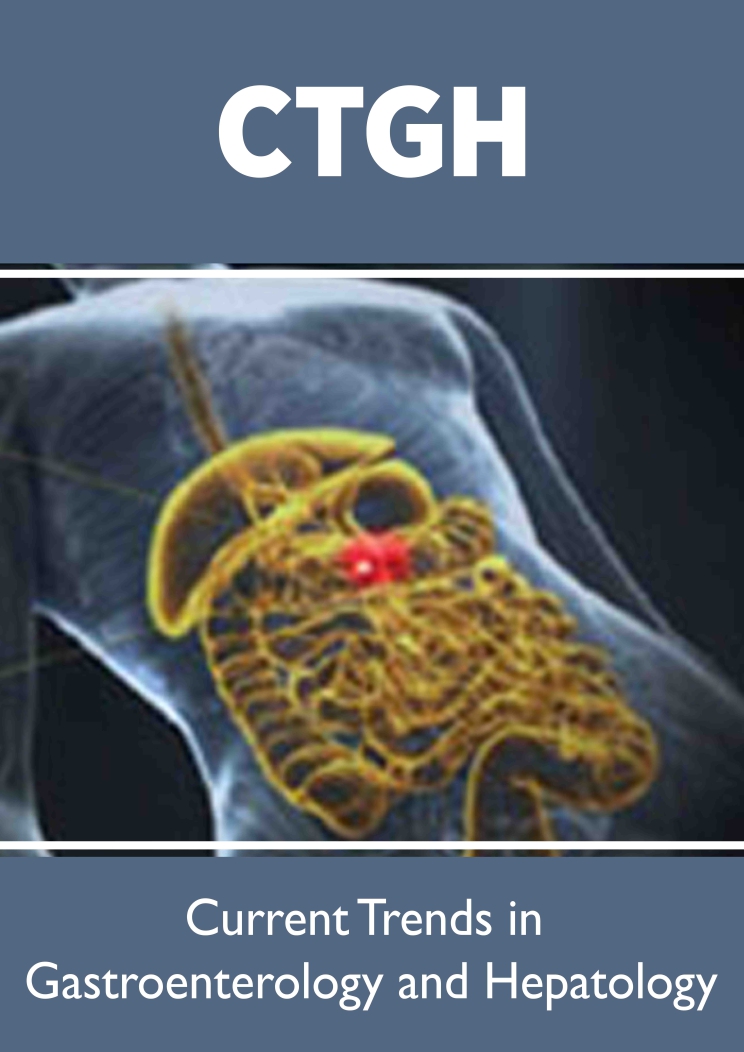
Lupine Publishers Group
Lupine Publishers
Menu
ISSN: 2641-1652
Case Report(ISSN: 2641-1652) 
Navigating The Path of Hepatocellular Carcinoma in a Complex Societal Fabric Volume 4 - Issue 4
Aarushi Sudan1*, Utkarsh Dayal2, Dharshana Prem Anand1, Jyoti Rani4 and Sammy Ho3
- 1Jacobi Medical Center, Bronx, New York, USA
- 2University College of Medical Sciences, New Delhi, India
- 3Montefiore Medical Center, Bronx, New York, USA
- 4Department of Forensic Science, SGT medical College, Gurgaon, India
Received: June 06, 2024; Published: June 13, 2024
*Corresponding author: Aarushi Sudan, Jacobi Medical Center, Bronx, New York, USA
DOI: 10.32474/CTGH.2024.04.000191
Abstract
In the United States, Hepatitis B virus (HBV)-associated hepatocellular carcinoma (HCC) is predominantly seen in patients from Sub-Saharian Africa and Eastern Asia where HBV infection is prevalent. Because of delayed diagnosis and resource-intensive management required to treat advanced disease, the prognosis of HCC is often very poor, even in otherwise healthy patients. Here, we present the case of a patient with advanced HBV-related HCC and aim to analyze the factors that led to this presentation in order to identify potential areas of intervention and develop strategies to prevent similar outcomes.
In 2019, a 52-year-old male from Ghana without any known medical history, initially presented to our hospital with complaint of dizziness. At the time, he was diagnosed with concomitant HIV and acute HBV infection and discharged with infectious disease (ID) clinic follow-up. Antiviral therapy including TAF was started, and Liver US was performed which showed coarse heterogeneous hepatic echotexture. He was enrolled in a Retention and Adherence Program to assist with insurance, medication procurement, and appointment scheduling. After being successfully discharged from RAP in September 2020, the patient’s insurance coverage was lost for seven consecutive months during which he was unable to procure antiviral medications or attend regular follow-up. With the involvement of social and financial services, in late December 2022, the patient’s insurance was re-instated, and he was linked to ID clinic to re-establish care. However, in April 2023, he presented to the ER for severe right upper quadrant abdominal pain. Further imaging was performed, and biopsy-proven advanced HBV-related HCC was diagnosed. He was discharged with close follow-up with oncology and is currently receiving Durvalumab and tremelimumab in oncology clinic.
Overall, this case highlights several hurdles and gaps that hamper care for immigrant patients in the US. Lack of longitudinal follow-up and cancer surveillance screening is ultimately responsible for advanced disease presentations requiring resourceintensive therapies and leading to dismal outcomes. Immigrants with HBV/HIV infections remain at high risk for HCC and face unique challenges that require a comprehensive and multidisciplinary approach to improve outcomes. Further natural history studies of HCC in HIV-HBV coinfection within these populations are needed to better understand disease progression and develop targeted interventions.
Introduction
Hepatocellular carcinoma (HCC) is a significant global health concern, ranking as the sixth most common cancer worldwide and the third leading cause of cancer-related deaths [1].
Geographically, the burden of HCC is concentrated in SubSaharan Africa and Eastern Asia, which together account for approximately 80% of the cases. Risk factors for HCC exhibit regional variations, with different etiological factors contributing to its development.
In regions with low incidence rates such as North America, Western, Central, and Eastern Europe, risk factors for HCC include genetic predisposition, chronic alcohol consumption, obesity, hemochromatosis, exposure to nitrosamines, and hepatitis C virus (HCV) infection [2]. Conversely, in Sub-Saharan Africa, which reports an annual incidence of 46,000 cases, hepatitis B virus (HBV) infection is the primary cause of HCC [3]. HCV exposure and dietary carcinogens, specifically aflatoxin B1, contribute to the remaining cases [4]. Notably, the annual mortality rate from HBV-associated HCC in Sub-Saharan Africa is equivalent to the total number of diagnosed HCC cases each year [5].
In the United States, majority of HBV-associated HCC is observed in immigrant populations originating from Sub-Saharan Africa and Eastern Asia, often presenting with a particularly poor prognosis [6]. The literature data on the clinical course and treatment of HBsAg-positive immigrants, a vulnerable population at risk for HCC, are scanty. Managing HBV infection in immigrant populations presents unique challenges and necessitates the involvement of expert personnel and dedicated structures for their assistance. In this context, social services, voluntary operators, and cultural mediators play vital roles in achieving optimized psychological and clinical intervention. In this article, we explore the case of a patient with HBV-related HCC, whose clinical management was compromised due to inadequate longitudinal follow-up, resulting in serious cancer outcomes. Our objective is to analyze the factors that may have contributed to this clinical deterioration and identify potential strategies for preventing such outcomes in the future.
Case Description
A 52-year-old male from Ghana, without any significant past medical history, initially presented to our hospital in 2019 due to dizziness. His blood work revealed HIV positivity (HIV viral load: 14584, CD4 count: 117) and acute hepatitis B (Hep B quantitative PCR: 1194056 IU/mL, HBsAg reactive, HBs antibody: non-reactive). Remainder of his labs were unremarkable with hemoglobin of 14g/ dl, Na 138 mmol/L, K 3.9 mmol/L, Cl 100 mmol/L, creatinine 0.9 mg/dL, ALP 99 U/L, SGOT 64 U/L, SGPT 46 U/L, LDH 258 U/L, CK 364 U/L.
After being discharged from the emergency room, the patient was linked to the Infectious Disease clinic for further caevaluation and management. No high-risk behaviors were identified upon further history, patient frequently traveled to Ghana but mostly ate a western diet, it was likely that he contracted HIV and hepatitis B at a young age. He was started on antiretroviral therapy (bictegravir, emtricitabine & tenofovir alafenamide), resulting in a decrease in HIV viral load to <20 and hep B quantitative DNA to 587IU/mL within a month. An ultrasound revealed a coarse heterogeneous echo texture with a borderline liver size.
In the setting of his recent diagnosis of HIV, the patient was enrolled in Retention and Adherence Program (RAP) at Jacobi Medical Center, where he received assistance with insurance, medication procurement, and appointment scheduling. He remained in the program for 15 months, during which time his viral load remained undetectable. Subsequently, he was successfully discharged from RAP in September 2020.
Unfortunately, the patient’s insurance coverage lapsed seven months later (April 2021), leading to the inability to procure medications. During this time, the patient traveled to Ghana without obtaining medication refills and could not be contacted. Efforts were made by the medical team to reach out to the patient, and insurance was reinstated upon his return to the US in December 2022.
The patient was eventually seen in the Infectious Diseases clinic in April 2023, presenting with right upper quadrant abdominal pain. Physical examination revealed tachycardia, low-grade fever, abdominal distension, and generalized mild abdominal tenderness. Laboratory tests showed a hemoglobin level of 8 g/dL(compared to a baseline of 14), and liver function tests indicated elevated ALT (681 U/L), AST (1518 U/L), ALP (246 U/L), and GGT (234 U/L). The patient’s HIV viral load remained undetectable, and the hepatitis B viral load was 14 IU/mL. Alpha-fetoprotein (AFP) was elevated at 1862 ng/mL, and LDH was 1400 U/L. Other tumor markers, such as CEA, were negative. Serology for Hepatitis D and hepatitis E was also negative. A CT scan of the abdomen revealed innumerable liver masses, a large volume of ascites, and enlargement of the portal system. The patient was admitted for anemia and received one unit of packed red blood cells (pRBCs) while being started on a pain control regimen. An image- guided paracentesis was performed, removing 700 mL of ascitic fluid. Cytology of the ascitic fluid was negative for malignancy but positive for red blood cells, and cultures were negative. A liver biopsy was subsequently performed, consistent with hepatocellular carcinoma (HCC), as confirmed by positive immunohistochemistry for Arginase 1, Hepatocyte, and Glypican-3 in neoplastic cells, indicative of moderately differentiated HCC. CD34 was highlighted in endothelial cells.
The imaging findings and ascitic fluid results suggested that the patient likely sustained a rupture of a subcapsular liver mass, resulting in intraperitoneal bleeding. The patient was closely monitored in the inpatient setting for further bleeding, but remained hemodynamically stable without any subsequent decrease in hemoglobin levels. Following this, the patient was discharged and is currently receiving chemotherapy with Durvalumab and tremelimumab in the oncology clinic.
Discussion
Hepatocellular carcinoma (HCC) is a major cause of cancerrelated morbidity and mortality worldwide, with a particularly poor prognosis compared to other gastrointestinal malignancies. In Sub-Saharan Africa (SSA), approximately 38,800 people are at risk of developing HCC each year due to hepatitis B infection.1 HCC associated with hepatitis B is also observed among immigrant populations from Sub-Saharan countries in the United States [7].
Existing literature on HBV-associated HCC highlights cases with uncontrolled viral levels and demonstrates a decrease in HCC incidence with effective antiretroviral therapy. However, our patient exhibited a fulminant cancer course despite suppressed viral levels. HIV coinfection likely played a contributing role in the development of HCC, as HIV affects hepatitis B pathogenesis through various mechanisms such as increasing HBV replication, promoting immune-mediated liver injury, and hepatotoxic effects of antiretroviral therapy [8]. Notably, HIV accelerates cirrhosis in hepatitis B patients. But similar to HBV associated HCC, most cases of HCC reported in HBV-HIV coinfected patients have been associated with low CD4 levels and high HBV viral loads [9]. Although dietary and environmental factors were not significant in this patient, alcohol use could have further predisposed him to develop cancer. This patient may have developed cirrhosis secondary to alcohol use as evidenced by early cirrhotic changes seen on imaging at initial presentation (Image A) Figure 1.
The patient described above developed morbid cancer outcomes despite being linked to appropriate outpatient services and Retention and Adherence program. While it is important to screen for malignancy at the time of diagnosis of hepatitis B, close follow up with serial imaging is vital. Imaging findings in the patient from initial presentation in 2019 and subsequently in 2023 are compared in the figure below. The first image shows the patient’s initial ultrasound where no liver masses can be appreciated. Image B is the patient’s ultrasound from four years later which illustrates innumerable masses consistent with metastatic liver disease. This reinforces the importance of existing cancer surveillance guidelines for HCC in hepatitis B patients. Cancer surveillance should be independent of response to antiviral therapy and viral loads. It is important to mention that although initial imaging did not reveal any masses, the liver appeared to have a coarse echotexture. Underlying pathologies such as abnormal liver texture, patient factors such as obesity and technical limitations such as quality of ultrasound can limit the sensitivity of HCC detection by US [10]. In a recent meta-analysis, surveillance ultrasound was found to have a sensitivity of 94% for detecting HCC lesions at any stage and a sensitivity of 63% for early-stage tumors [11]. The same study also noted that adding AFP to the Ultrasound regimen did not improve sensitivity. Increasing the frequency of US to every 6 months in contrast to annually increased the sensitivity to 70% in detecting early-stage HCC. Another study conducted in South Korean patients in 2017 found that surveillance MRI with liver specific contrast had a higher detection rate and a lower false-positive rate. MRI was significantly more sensitive in detecting very early-stage HCC (lesions < 2 cm) with a sensitivity of 84.8% compared to 27.3% by ultrasound [12]. However, surveillance with MRI is limited by cost. MRI or CT are not recommended as primary imaging techniques for HCC surveillance but should be considered in such high-risk patients with underlying liver pathology [13]. Ultrasound could, therefore, have been followed by an MRI in this case as underlying pathology of the liver limited the sensitivity of ultrasound in picking up an early HCC related lesion.
Social issues, including access to healthcare and loss of followup, can significantly impact patient outcomes. African immigrants, in particular, remain at high risk for HCC due to the prevalence of hepatitis B infections and high HBV-HIV coinfection rates. Many of them have language barriers, are unable to afford health insurance and may carry asymptomatic chronic infections, such as those related to hepatitis B virus (HBV), hepatitis C virus (HCV) and human immunodeficiency virus (HIV). To better tackle these social issues in the future, it is crucial to establish a long-term action plan in clinical settings. This plan should involve comprehensive patient education, culturally sensitive healthcare delivery, improved access to healthcare services, and effective retention and adherence programs. Collaborative efforts between healthcare providers, social services, voluntary operators, and cultural mediators are essential in achieving optimized psychological and clinical interventions for these patients.
In conclusion, HCC associated with HBV is an important preventable cancer with poor prognosis. African immigrants and individuals with HBV-HIV coinfection face unique challenges that require a comprehensive and multidisciplinary approach to improve outcomes. Further natural history studies of HCC in HIV-HBV coinfection within these populations are needed to better understand disease progression and develop targeted interventions.
Conflicts of Interest:
The authors declare no conflicts of interest.
References
- Sung H, Ferlay J, Siegel RL, Mathieu Laversanne, Isabelle Soerjomataram et al. (2021) Global Cancer Statistics 2020: GLOBOCAN Estimates of Incidence and Mortality Worldwide for 36 Cancers in 185 Countries. CA Cancer J Clin 71(3): 209-249.
- Baecker A, Liu X, La Vecchia C, Zhang ZF (2018) Worldwide incidence of hepatocellular carcinoma cases attributable to major risk factors. Eur J Cancer Prev 27(3): 205-212.
- Ezzat R, Eltabbakh M, El Kassas M (2021) Unique situation of hepatocellular carcinoma in Egypt: A review of epidemiology and control measures. World J Gastrointest Oncol 13(12):1919-1938.
- Maucort Boulch D, De Martel C, Franceschi S, Plummer M (2018) Fraction and incidence of liver cancer attributable to hepatitis B and C viruses worldwide. Int J Cancer 142(12): 2471- 2477.
- Matthews PC, Kramvis A (2022) Hepatitis B virus (HBV) and hepatocellular carcinoma (HCC) in sub- Saharan Africa: no room for complacency. Hepatoma Res 8(3): 1-5.
- Anugwom CM, Allaire M, Akbar SMF, Amir Sultan, Steven Bollipo, et al. (2021) Hepatitis B-related hepatocellular carcinoma: surveillance strategy directed by immune-epidemiology. Hepatoma Res. Published online 7(23): 1-2.
- Okeke E, Davwar PM, Roberts L, Kurt Sartorius, Wendy Spearman, et al. (2020) Epidemiology of Liver Cancer in Africa: Current and Future Trends. Semin Liver Dis 40(2): 111-123.
- Singh KP, Crane M, Audsley J, Avihingsanon A, Sasadeusz J, et al. (2017) HIV-hepatitis B virus coinfection: epidemiology, pathogenesis, and treatment. AIDS 31(15): 2035-2052.
- Gjærde LI, Shepherd L, Jablonowska E, Adriano Lazzarin, Mathieu Rougemont, et al. (2016) Trends in Incidences and Risk Factors for Hepatocellular Carcinoma and Other Liver Events in HIV and Hepatitis C Virus–coinfected Individuals From 2001 to 2014: A Multicohort Study. Clin Infect Dis 63(6): 821-829.
- Danila M, Ioan Sporea (2014) Ultrasound screening for hepatocellular carcinoma in patients with advanced liver fibrosis. An overview. Med Ultrason 16(2): 139-144.
- Singal A, Volk ML, Waljee A, P Higgins, M A M Rogers, et al. (2009) Meta-analysis: surveillance with ultrasound for early- stage hepatocellular carcinoma in patients with cirrhosis. Aliment Pharmacol Ther 30(1): 37-47.
- Kim SY, An J, Lim YS, , Seungbong Han, Ji-Young Lee, et al. (2017) MRI With Liver-Specific Contrast for Surveillance of Patients With Cirrhosis at High Risk of Hepatocellular Carcinoma. JAMA Oncol3(4): 456-463.
- Marrero JA, Kulik LM, Sirlin CB, Andrew X Zhu , Richard S Finn, et al. (2018) Diagnosis, Staging, and Management of Hepatocellular Carcinoma: 2018 Practice Guidance by the American Association for the Study of Liver Diseases. Hepatology 68(2): 723-750.

Top Editors
-

Mark E Smith
Bio chemistry
University of Texas Medical Branch, USA -

Lawrence A Presley
Department of Criminal Justice
Liberty University, USA -

Thomas W Miller
Department of Psychiatry
University of Kentucky, USA -

Gjumrakch Aliev
Department of Medicine
Gally International Biomedical Research & Consulting LLC, USA -

Christopher Bryant
Department of Urbanisation and Agricultural
Montreal university, USA -

Robert William Frare
Oral & Maxillofacial Pathology
New York University, USA -

Rudolph Modesto Navari
Gastroenterology and Hepatology
University of Alabama, UK -

Andrew Hague
Department of Medicine
Universities of Bradford, UK -

George Gregory Buttigieg
Maltese College of Obstetrics and Gynaecology, Europe -

Chen-Hsiung Yeh
Oncology
Circulogene Theranostics, England -
.png)
Emilio Bucio-Carrillo
Radiation Chemistry
National University of Mexico, USA -
.jpg)
Casey J Grenier
Analytical Chemistry
Wentworth Institute of Technology, USA -
Hany Atalah
Minimally Invasive Surgery
Mercer University school of Medicine, USA -

Abu-Hussein Muhamad
Pediatric Dentistry
University of Athens , Greece

The annual scholar awards from Lupine Publishers honor a selected number Read More...



